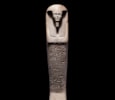Shabti For Seni-Em-Iah
Shabti For Seni-Em-Iah
Egypt
New Kingdom 1550 - 1077 B.C.
Limestone
H: 32.7 cm x W: 7 cm
Sold
From the Second Intermediate Period – New Kingdom, 17th-18th Dynasty, more specifically 1550-1525 B.C. Carved from a high-quality limestone, this shabti represents a figure in mummiform. The style and nemes headdress reflect the association of the owner, Seni-em-Iah, with the funerary deity Osiris, and the shabti formula inscribed on the body is an early example of text drawn from Chapter 6 of the Book of the Dead, a magical formula dedicated to the shabti funeral figurines that were an important part of the Egyptian burial inventory. Horizontal bands of hieroglyphic text run down the lower half of the body, and give the name of the owner, ‘Seni-em-Iah’, whilst a vertical line of text reads, “It is his brother who makes his name to live, Pa-kem”, giving the name of the donor as the deceased’s brother, Pa-Kem. A seated limestone statuette in Dublin (acc. no. 30/002) bearing an inscription naming a priest of Khonsu called Sen-em-Iah is more likely to belong to the same man as the present shabti figure, dating as it must stylistically to the transition between the 17th and 18th Dynasty. The unique stylisation and angular treatment reflect the decoration of elite rishi-type coffins of the late 17th Dynasty, including the coffin of King Kamose in Cairo (G. Daressy, “Le cercueil du roi Kames,” ASAE 9, pp. 61-3, pl. 9) and the coffin of a noblewoman found by Petrie at Sheikh Abd el-Qurna, now in Edinburgh (acc. no. 1909.527.1). In particular, the nearly horizontal treatment of the wings of the nemes headdress and angular, serious nature of the face are reflected in these and other 17th Dynasty wooden coffins. During the 17th Dynasty most shabtis were simple ‘stick shabtis’ created from simple slim pieces of wood, therefore this limestone shabti is somewhat unique for its dating. However, the use of the downturned moon symbol in the name of ‘Seni-em-Iah’ indicates that the shabti’s inscription dates to the end of the reign of Ahmose, following the reunification of Egypt (i.e., after years 18-22 of the reign), as documented extensively by C. Vandersleyen (Les guerres d'Amosis, fondateur du Nouvel Empire). It is possible the carving of the shabti and the inscription were done at different times.
The Property of William Randolph Hearst, Sotheby & Co, London, 11-12 July 1939, Lot 46A.
Fine Antiquities and Pre-Columbian Works of Art, Harmer Rooke / Malter, New York, 3 May 1978, Lot 95A.
David Aaron Ltd, 2022, No. 2.
Previously in the Private Collection of Mr William Randolph Hearst (1863-1951), New York and California, from at least 1939.
Sold at: The Property of William Randolph Hearst, Sotheby & Co, London, 11-12 July 1939, Lot 46A.
With Spink & Son, London, probably during the 1950s/1960s. (photographed)
With J.J. Klejman (1906-1995), 982 Madison Avenue, New York, from at least 1967.
Private Collection, New York, acquired from the above, 1967 (accompanied by notarised affidavit).
Private Collection, USA.
ALR: S0021266, with IADAA Certificate, this item has been checked against the Interpol database.
William Randolph Hearst (1863-1951) was born on April 29th, 1863, in San Francisco, California, the only child of George and Phoebe Hearst. His father, a wealthy man as a result of relentless work and creativity in his various mining interests, allowed young William the opportunity to see and experience the world as few do.
In 1903, Mr. Hearst married Millicent Willson in New York City. The couple had five sons together during their marriage: George, William Randolph Jr., John and twins Randolph and David.
Their honeymoon drive across the European continent inspired Mr. Hearst to launch his first magazine, Motor. Motor became the foundation for another publishing endeavour that is still known as Hearst Magazines.
Hearst’s interest in politics led him to election to the United States House of Representatives as a Congressman from New York in 1902. Re-elected in 1904, he unsuccessfully pursued the New York Governorship in 1906.
In the 1920s he started one of the first print-media companies to enter radio broadcasting. Hearst was a major producer of movie newsreels with his company Hearst Metrotone News, and is widely credited with creating the comic strip syndication business. His King Features Syndicate today is the largest distributor of comics and text features in the world. In his career, William Hearst produced over 100 films including, “The Perils of Pauline,” “The Exploits of Elaine” and “The Mysteries of Myra.” In the 1940s he was an early pioneer of television.
In addition to his brilliant business endeavours, Mr. Hearst amassed a vast and impressive art collection that included American paintings, European Old Master paintings and sculptures, tapestries, oriental rugs, Greek, Roman and Egyptian antiquities, silver, furniture and historic ceilings. Hearst began selling some of his art collection in the mid-30s to help relieve the debt burden he had suffered from the great Depression.
It is strongly believed that the main character, ‘Charles Foster Kane’ in Orson Wells’ film ‘Citizen Kane’ (1941) is loosely based on Hearst. Hearst was enraged at the idea of Citizen Kane being a thinly disguised and very unflattering portrait of him and used his massive influence and resources to prevent the film from being released—all without even having seen it. Welles and the studio RKO Pictures resisted the pressure but Hearst and his Hollywood friends ultimately succeeded in forcing theatre chains to limit showings of Citizen Kane, resulting in only moderate box-office numbers and seriously impairing Welles' career prospects. Despite Hearst’s efforts, however, the film is widely considered one of the greatest of all time.










 Enquire
Enquire




